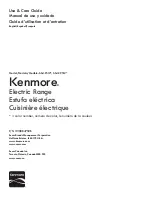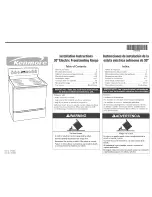
3
Important Safety Instructions
IMPORTANT SAFETY NOTICE
• The California Safe Drinking Water and Toxic
Enforcement Act requires the Governor of
California to publish a list of substances known to
the state to cause cancer, birth defects or other
reproductive harm, and requires businesses to warn
customers of potential exposure to such substances.
• Gas appliances can cause minor exposure to
four of these substances, namely benzene, carbon
monoxide, formaldehyde and soot, caused
primarily by the incomplete combustion of natural
gas or LP fuels. Properly adjusted burners,
indicated by a bluish rather than a yellow flame,
will minimize incomplete combustion. Exposure to
these substances can be minimized by venting with
an open window or using a ventilation fan or hood.
When You Get Your Range
• Have the installer show you the location of the
range gas cut-off valve and how to shut it off
if necessary.
• Have your range installed and properly
grounded by a qualified installer, in accordance
with the Installation Instructions. Any adjustment
and service should be performed only by qualified
gas range installers or service technicians.
• Plug your range into a 120-volt grounded
outlet only. Do not remove the round grounding
prong from the plug. If in doubt about the
grounding of the home electrical system, it is your
personal responsibility and obligation to have an
ungrounded outlet replaced with a properly
grounded, three-prong outlet in accordance with
the National Electrical Code NFPA–70 latest
edition. In Canada, the appliance must be
electrically grounded in accordance with the
Canadian Electrical Code. Do not use an
extension cord with this appliance.
• Do not attempt to repair or replace any
part of your range unless it is specifically
recommended in this guide. All other servicing
should be referred to a qualified technician.
• Locate range out of kitchen traffic path and
out of drafty locations to prevent pilot outage
(on standing pilot models) and poor air
circulation.
• Be sure all packing materials are removed from
the range before operating it to prevent fire or
smoke damage should the packing material ignite.
• Be sure your range is correctly adjusted by a
qualified service technician or installer for the
type of gas (natural or LP) that is to be used.
Your range can be converted for use with either
type of gas. See the Installation Instructions.
WARNING: These adjustments must be made by
a qualified service technician in accordance with
the manufacturer’s instructions and all codes and
requirements of the authority having jurisdiction.
Failure to follow these instructions could result in
serious injury or property damage. The qualified
agency performing this work assumes
responsibility for the conversion.
• After prolonged use of a range, high floor
temperatures may result and many floor
coverings will not withstand this kind of use.
Never install the range over vinyl tile or linoleum
that cannot withstand such type of use. Never
install it directly over interior kitchen carpeting.
Using Your Range
• CAUTION: ITEMS OF INTEREST TO
CHILDREN SHOULD NOT BE STORED IN
CABINETS ABOVE A RANGE OR ON THE
BACKSPLASH OF A RANGE—CHILDREN
CLIMBING ON THE RANGE TO REACH
ITEMS COULD BE SERIOUSLY INJURED.
WARNING
—All ranges can
tip and injury could result. To
prevent accidental tipping of the
range, attach an approved Anti-Tip
device to the floor. (See Installation
Instructions.) To check if the device is
installed and engaged properly,
carefully tip the range forward. The
Anti-Tip device should engage and
prevent the range from tipping over. If you pull the
range out from the wall for any reason, make sure
the Anti-Tip device is engaged when you push the
range back against the wall.
If it is not, there is a possible risk of the range
tipping over if you or a child stand, sit or lean on
an open door.
(continued next page)
IMPORTANT SAFETY INSTRUCTIONS
Read all instructions before using this appliance.
Summary of Contents for JGAS24
Page 34: ...34 NOTES...




































